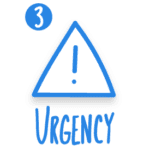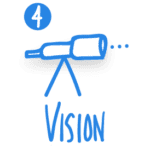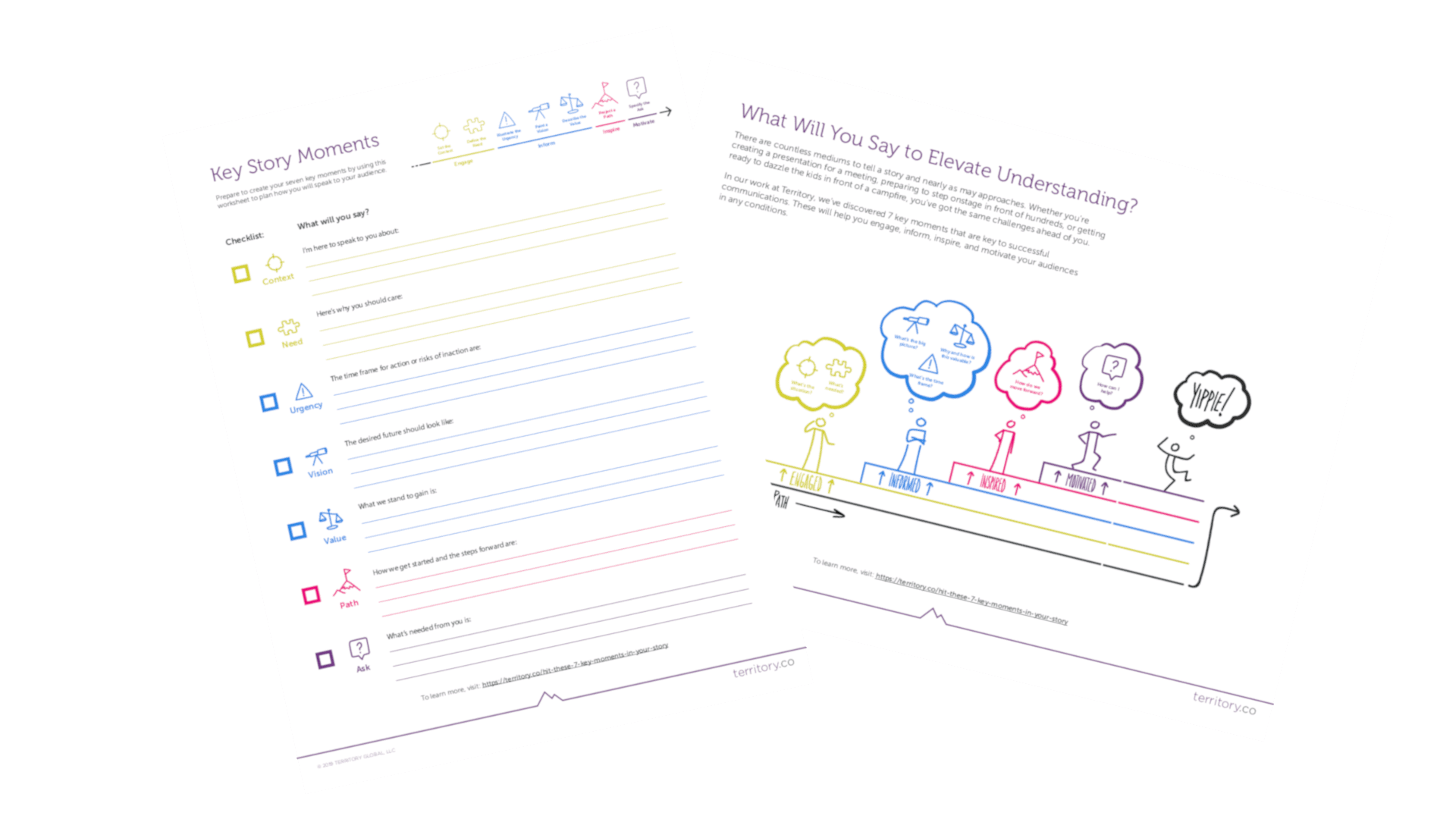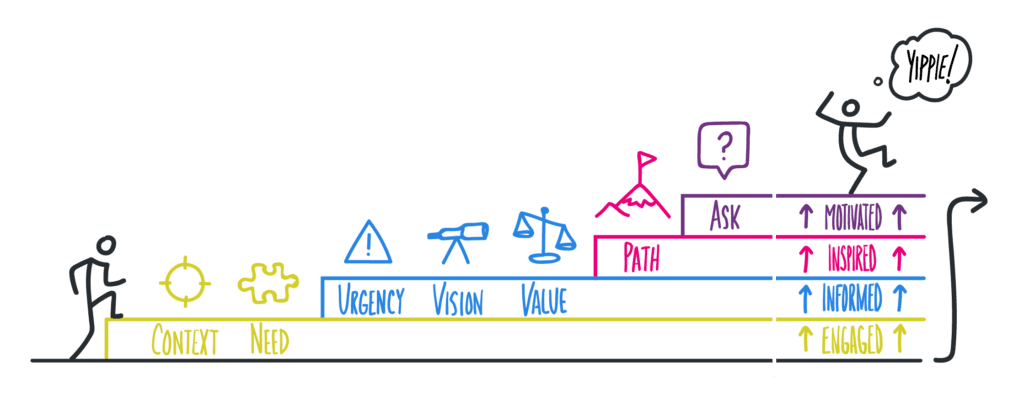Hit these seven key moments in your story
Wednesday, March 20, 2019
Article 3 in the 3-part series Craft Your Story
There are countless mediums to tell a story and nearly as may approaches. Whether you’re creating a presentation for a meeting, preparing to step onstage in front of hundreds, or getting ready to dazzle the kids in front of a campfire, you’ve got the same challenges ahead of you. Here is a formula to make sure your story has all the essentials.
Remember Saturday morning cartoons?
Once upon a time, in a studio far far away, I taught your kids how to draw silly faces. I was working with a large group of passionate young adults boldly bent upon, “entertaining and educating kids,” around the world. We created engaging K-12 curriculum, an acclaimed digital learning platform, and even a television show that entertained (and yes, educated) kids on CBS Saturday Mornings.
It was a defining chapter in my early career, and while I can’t take much credit for most of their star-touched achievements, I can proudly say that I got to do good work where it counts: face to face with kids.
Our outreach program was a field team of energized artists and storytellers that would travel around the country giving shows and lessons at events and schools; on occasion I would accompany the team and help out.
It turns out there’s a trick to promoting fun while also preventing chaos in a room filled with feral muskrats. I learned (yes, the hard way) that when working with children, one must quickly and clearly:
- Get their attention: Create a moment that’s far more interesting than what they’re currently doing
- Keep their attention: Give them something to chew on—figuratively or literally
- Help them understand how: Share a secret that only you know
- Leave them with something to do: Give a tantalizing objective that drives them to act immediately
You can see where I’m going with this, as it is a mirror of what I wrote about in Shape Your Message. That article spoke to a method to help you organize your content into an easy to digest framework as such:
- Engage: Pull your audience in by painting a picture that they can relate to and visualize themselves within
- Inform: Work to reach a common understanding by setting a baseline, then highlighting data they may not yet have
- Inspire: Illustrate potential solutions
- Motivate: Give your audience a reason to act
The only real difference between the two audiences is that an adult audience usually has a specific drive for why they’re there. They arrive with a mental list of desires and expectations. Your not-so-simple job is to understand their desires and expectations and then present your message in a way that speaks directly to them. I point you back to the first article in this series, Strike the Right Tone, as a refresher.
The Seven Key Moments
Circumstances don’t always allow for meaningful dialogue, so it’s important to get your message across in an efficient and engaging manner. You need to learn to be an effective communicator in both synchronous and asynchronous formats.

In our work at Territory, we’ve discovered 7 key moments that are key to successful communications. These will help you engage, inform, inspire, and motivate your audiences in any conditions.
Follow these steps to ensure that your audience joins you in your story:

-
- Set the context: No matter who is in your audience, start off by giving them a taste of what you’re about to say. Frame it for them in the easiest possible way to understand.
- Tell your audience why you’re here. Thank your audience for their time and explain why you’re driven to speak with them.
- Use your understanding of the audience and the expectations that they might be bringing with them to create a frame for your topic. What’s inside that frame, and what’s outside that frame that they might be expecting to hear? Declaring what you’re not going to be talking about can help your audience better focus their listening.
- Why is this topic personally important to you? Share an interesting background story that brought you to this moment. A strong start will set context, create engagement, and help generate crucial momentum.
- Set the context: No matter who is in your audience, start off by giving them a taste of what you’re about to say. Frame it for them in the easiest possible way to understand.

-
- Define the need: Why should they care? You’ve told them why this is important to you; Now draw the connection to them personally.
- Is there a course correction needed, a gap to be filled, or an effort that should be amplified? Use a, start / stop / continue method to frame the change.
- Underline the specific opportunity for change.
- If possible, seed the concept behind what you’ll be asking from them at the end.
- Define the need: Why should they care? You’ve told them why this is important to you; Now draw the connection to them personally.

-
- Illustrate the urgency: Now that you’ve defined what needs to happen, explain when to illustrate the importance of timing.
- If you’re proposing an immediate action, answer the question, Why now?
Speak to risks. Tell how will they may be impacted if no action is taken. - Trigger an emotional response by drawing connectors from your topic to the needs of your audience.
- If you’re proposing an immediate action, answer the question, Why now?
- Illustrate the urgency: Now that you’ve defined what needs to happen, explain when to illustrate the importance of timing.

-
- Paint a vision: What’s the way forward? Paint a picture of the possible future.
- Enroll the audience in the idea of a better way.
- Show them their place in the picture.
- Describe what would change and how.
- Paint a vision: What’s the way forward? Paint a picture of the possible future.

-
- Describe the value: What is it you’re proposing, and what’s the potential gain? Provide answers — formulated or hypothetical.
- Why might it work? It’s more important to explain why than how.
- How could forces combine to create change?
- For a yet-to-be-engaged audience, what’s in it for them?
- Describe the value: What is it you’re proposing, and what’s the potential gain? Provide answers — formulated or hypothetical.

-
- Project a path: You’ve defined a desired end-state; now speak to the road ahead that could lead to a tangible solution. What needs to happen to enable your vision, and what pathways might be taken to get us there?
- Paint a vivid image of what the path might look and feel like—your audience needs to understand their role in a successful outcome.
- Pull in elements of need and vision to show how the various forces could unite to create momentum toward the goal.
- Illustrate obstacles, challenges, and opportunities.
- If there’s time, again depict current and future states to illustrate needed action.
- Don’t be too prescriptive. Enabling your audience to develop their own path gives them ownership, which significantly increases the changes they’ll succeed.
- Project a path: You’ve defined a desired end-state; now speak to the road ahead that could lead to a tangible solution. What needs to happen to enable your vision, and what pathways might be taken to get us there?

-
- Specify the ask: Now that you’ve told them your story, what are you asking?
- Enroll them again in the ask.
- Tell them what to expect from you next.
- Feed their curiosity by pointing them to additional resources.
- Enable their involvement by providing a way to get and stay involved.
- Specify the ask: Now that you’ve told them your story, what are you asking?
Use this worksheet to help gather and organize your ideas:
Download the Key Story Moments Worksheet

Behold: the big picture
Crafting your tone, framing your story, and honing your message can create a basis for good storytelling. In, Strike the Right Tone for Your Audience, we covered some fundamental steps in understanding and creating empathy for the people to whom you’re speaking. Shape Your Message was all about engaging, informing, inspiring, and motivating your audience. Now, in Hit Seven Key Moments, we covered seven fundamental moments that will resonate with your audience.
Now that you’ve completed the fundamentals, here are two additional ways you can bring it all together:
Overlay Your Key Moments to Shape Your Story
Using the 7 key moments in conjunction with the lantern framework, will unlock a formula to create engaged, informed, inspired, and motivated audiences.
- Use Context and Need to create an approach that grabs attention. Using these common storytelling mechanisms is a an effective way to warm-up and engage your audience.
- Use Urgency, Vision, and Value to approach new or complex ideas. Learning how to explain your content in a clear and simple way will help you inform your audience.
- Make your message feel personal by painting your audience into the Path forward. Finding ways to relate your ideas to the individuals you’re communicating to will help them see themselves in the picture you’re painting. They will become inspired to get involved.
- Customize your Ask to map to the personal or cultural tendencies of your audience. Learn what motivates your audience then offer incentives that map to their values.

Overlaying the 7 key story moments to the Lantern framework can turn yours into an engaged, informed, inspired, and motivated audience.
Use the Story Moments worksheet to bring your moments together, making sure to refer to your story shape to help refine your message to match the type of story you intend to tell.
Use this as a guide
You don’t always need to hit all seven key moments to create a compelling story. They’re there to help organize your thinking and also to act as a safety net as you outline your story.
More seasoned presenters may find creating seven distinct statements to be overly prescriptive or heavy-handed. If this is you, and you’re looking to hone-down your message or condense the total time your story will take to tell, you might consider marrying-up two or three moments into singular points that map to your four-part story shape.
Download the Key Story Moments Worksheet

Flavor your message with the right tone
No matter your skill or experience level, understanding your audience and their needs is the best starting point when creating a relatable and understandable message.
As you start down the path to crafting your story, refer back to your work in the empathy diamond to strike the right tone using audience-specific language. Make sure to use:
- Relationship: Who are they? Are there any common touch points between you and your audience?
- Familiarity: How familiar is the audience with your topic? How much groundwork will need to be established?
- Convention: How willing are is your audience to be led along a story?
- Disposition: What kind of relationship do you have with your audience? How formal should you be?
Notes of encouragement
Stage fright is commonplace
If you’re like me, you probably feel anxiety about speaking in front of others. In fact, an audience is giving you time they could be doing other things . . . and everyone’s time is precious. An audience that feels like “this better be good” isn’t wrong to feel that way!
Your audience isn’t concocted of Malfoys — it’s actually packed with Weasleys!
But you should know that the vast majority of people in an audience want to see you succeed. Your fear might be hearing, “This better be good,,” but in reality, in reality, they’re saying, “Give me your best,” so, give it to them! After all, you’ve got something to offer or you wouldn’t be presenting in the first place. If you do well, they’ll get something good in return. They’ll be entertained, or they’ll learn something, or they’ll leave with information they can share. They may even ask you for more!
Don’t fall into the impostor syndrome trap
You’re not the world’s top expert on your topic? Who cares! Speak to your passions. Be an instigator of new thinking. Spark curiosity in your audience and enroll others in your ideas.
Be yourself
Your content is important, but you are the true differentiator and the one thing people will be experiencing. Your content and methods should be a mirror of the best you, so play to your strengths. If you’re personable, interact with your audience. If you’re funny, be hilarious. If you’re wise, share your knowledge.
You’ve got this
My goal when building this series was to create four bite-sized storytelling tools to help you craft more engaging presentations. I shared personal stories and provide tools to help you craft your next best story. Along the way, I was reminded of my true passion.
What drives me in my work is learning and sharing with other creatives so we can cultivate and spread a culture of creativity. I sincerely hope that I’ve informed and inspired you in some way, and that you feel motivated to continue to improve your ability as a communicator.
I’d love to hear how it goes.


